
|
Now it is bright as 8.8 mag (Sept. 25, Chris Wyatt). It is observable at 8 mag for a long time from 2022 to 2023. In the Southern Hemisphere, it stays observable for a long time, although it becomes low temporarily from November to December. In the Northern Hemisphere, it is not observable until 2023 summer.
Date(TT) R.A. (2000) Decl. Delta r Elong. m1 Best Time(A, h)
Oct. 15 16 5.75 -37 15.7 2.514 1.982 47 8.2 18:49 ( 46, -4)
Oct. 22 16 11.33 -39 30.2 2.548 1.947 43 8.2 18:41 ( 46, -7)
|
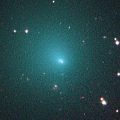
|
Now it is very bright as 10.7 mag (Oct. 2, Marco Goiato). It stays 10 mag until November. In the Northern Hemisphere, it becomes unobservable soon. In the Southern Hemisphere, it becomes unobservable temporarily from December to January.
Date(TT) R.A. (2000) Decl. Delta r Elong. m1 Best Time(A, h)
Oct. 15 21 34.90 -41 52.8 1.092 1.696 108 10.1 19:57 ( 0, 13)
Oct. 22 20 55.64 -42 24.7 1.249 1.668 95 10.1 18:51 ( 0, 13)
|
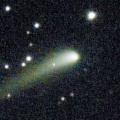
|
Now it is bright as 11.4 mag (Oct. 8, Osamu Miyazaki). It will approach to Earth down to 0.29 a.u. in 2023 February, and it is expected to brighten up to 5 mag. In the Northern Hemisphere, it stays observable in excellent condition. In the Southern Hemisphere, it is not observable until early February.
Date(TT) R.A. (2000) Decl. Delta r Elong. m1 Best Time(A, h)
Oct. 15 15 51.41 26 12.7 2.238 1.782 50 11.3 18:49 (102, 32)
Oct. 22 15 50.20 25 32.2 2.211 1.704 47 11.0 18:41 (103, 27)
|
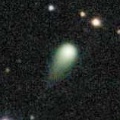
|
Now it is 12.0 mag (Oct. 3, Osamu Miyazaki). It is expected to brighten up to 10 mag in 2023. In the Northern Hemisphere, it stays observable in good condition until 2023 autumn, although it became very low temporarily in summer. In the Southern Hemipshere, it stays unobservable until 2023 summer.
Date(TT) R.A. (2000) Decl. Delta r Elong. m1 Best Time(A, h)
Oct. 15 10 55.64 56 31.4 3.370 3.191 71 11.7 4:41 (222, 39)
Oct. 22 11 0.47 57 58.1 3.218 3.139 76 11.5 4:47 (221, 43)
|
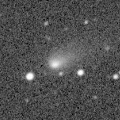
|
Now it is 12.1 mag (Oct. 3, Ken-ichi Kadota). It will appear in the morning sky in November also in the Southern Hemisphere. It stays 11-12 mag until spring.
Date(TT) R.A. (2000) Decl. Delta r Elong. m1 Best Time(A, h)
Oct. 15 10 58.46 6 49.6 2.380 1.710 38 12.1 4:41 (275, 19)
Oct. 22 11 17.15 5 2.5 2.322 1.687 40 12.0 4:47 (279, 21)
|

|
It brightened up to 8.3 mag in last winter (Jan. 6, Toshiyuki Takahashi). Now it is fading. But it is bright as 10.9 mag still now (Oct. 5, Thomas Lehmann).
Date(TT) R.A. (2000) Decl. Delta r Elong. m1 Best Time(A, h)
Oct. 15 9 41.87 -14 24.5 4.863 4.343 53 12.1 4:41 (306, 20)
Oct. 22 9 46.17 -15 55.7 4.821 4.378 58 12.1 4:47 (312, 24)
|
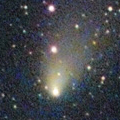
|
It brightened up to 10.4 mag from June to July (July 22, Ken-ichi Kadota). Appearing in the morning sky in the Souther Hemisphere. It will never be observable again in the Northern Hemisphere.
Date(TT) R.A. (2000) Decl. Delta r Elong. m1 Best Time(A, h)
Oct. 15 12 59.42 -40 53.0 2.369 1.624 32 12.1 4:41 (301,-30)
Oct. 22 13 20.05 -44 41.8 2.430 1.702 34 12.4 4:47 (306,-29)
|
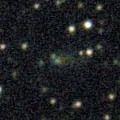
|
Now it is 12.8 mag (Oct. 1, Thomas Lehmann). It is expected to brighten very rapidly up to 11-12 mag in winter, and it will be observable in excellent condition.
Date(TT) R.A. (2000) Decl. Delta r Elong. m1 Best Time(A, h)
Oct. 15 7 24.06 11 6.3 1.566 1.861 90 12.7 4:41 (322, 61)
Oct. 22 7 37.05 10 28.2 1.495 1.851 93 12.4 4:47 (332, 63)
|
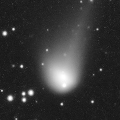
|
Now it is bright as 12.8 mag (Aug. 28, Hiroshi Abe). It stays 12 mag for a while. It becomes unobservable from August to November in the Northern Hemisphere, or from September to December in the Southern Hemisphere.
Date(TT) R.A. (2000) Decl. Delta r Elong. m1 Best Time(A, h)
Oct. 15 13 45.62 -3 5.2 5.357 4.374 8 12.7 18:49 ( 93,-10)
Oct. 22 13 53.35 -3 5.4 5.371 4.388 8 12.7 18:41 ( 95,-12)
|
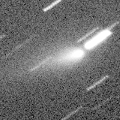
|
Outburst occured in early October. Now it is very bright as 10.7 mag (Oct. 14, Juan Jose Gonzalez). It stays observable in good condition in the Southern Hemisphere. It locates low in the Northern Hemisphere. Michael Jager detected several fragments at 17.5-19 mag.
Date(TT) R.A. (2000) Decl. Delta r Elong. m1 Best Time(A, h)
Oct. 15 18 15.16 -36 5.4 1.038 1.201 72 12.8 18:49 ( 26, 13)
Oct. 22 18 57.13 -35 44.6 1.089 1.257 74 13.2 18:41 ( 22, 15)
|
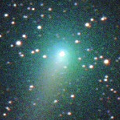
|
It brightened up to 9.3 mag in early summer (June 5, Chris Wyatt). Now it is fading. It has already faded down to 12.4 mag (Oct. 1, Thomas Lehmann). In the Southen Hemisphere, it stays observable in good condition for a long time. In the Northern Hemisphere, it will be observable after November.
Date(TT) R.A. (2000) Decl. Delta r Elong. m1 Best Time(A, h)
Oct. 15 10 13.82 -40 1.9 2.853 2.371 51 12.8 4:41 (318, -3)
Oct. 22 10 12.81 -40 31.6 2.854 2.427 55 13.0 4:47 (324, 1)
|

|
Now it is 13.1 mag (Oct. 2, Toshihiko Ikemura, Hirohisa Sato). It is expected to brighten up to 11 mag in 2023. In the Northern Hemisphere, it stays observable in good condition until November. But it becomes unobservable after that. In the Southern Hemisphere, it stays observable in good condition for a long time, although it becomes unobservable temporarily from November to January.
Date(TT) R.A. (2000) Decl. Delta r Elong. m1 Best Time(A, h)
Oct. 15 17 21.65 -11 10.5 4.060 3.661 59 13.2 18:49 ( 52, 27)
Oct. 22 17 25.02 -12 39.7 4.124 3.626 53 13.2 18:41 ( 54, 23)
|

|
The condition is worst in this apparition. It is not observable at all.
Date(TT) R.A. (2000) Decl. Delta r Elong. m1 Best Time(A, h)
Oct. 15 14 41.19 -10 16.7 2.013 1.133 20 13.3 18:49 ( 79, -2)
Oct. 22 15 9.52 -12 24.4 2.048 1.171 20 13.8 18:41 ( 76, -2)
|
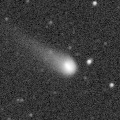
|
Now it is 13.7 mag (Sept. 24, Hiroshi Abe). It is expected to brighten up to 12 mag in 2023. In the Northern Hemisphere, it stays observable in good condition for a long time, although it becomes unobservable temporarily in October. In the Southern Hemisphere, it is not observable until mid December. But it will be observable in good condition in 2023.
Date(TT) R.A. (2000) Decl. Delta r Elong. m1 Best Time(A, h)
Oct. 15 13 36.77 13 43.2 4.821 3.919 22 13.4 18:49 (108, -2)
Oct. 22 13 39.15 12 34.8 4.788 3.895 23 13.4 4:47 (252, -3)
|
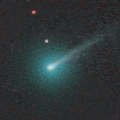
|
It brightened rapidly up to 12.4 mag in early October (Oct. 2, Michael Jager). Then it became fainter a bit, 13.0 mag (Oct. 9, Michael Jager). Although it is a tiny comet, it will approach to Sun down to 0.63 a.u. on Oct. 25. In the Northern Hemisphere, it is observable until late October. In the Southern Hemisphere, it is not observable after this.
Date(TT) R.A. (2000) Decl. Delta r Elong. m1 Best Time(A, h)
Oct. 15 12 4.61 24 4.2 1.090 0.670 37 13.4 4:41 (251, 16)
Oct. 22 12 58.28 19 34.6 1.183 0.636 32 13.4 4:47 (252, 9)
|

|
Now it is 15.9 mag (Oct. 10, ATLAS-HKO, Haleakala). It is expected to brighten up to 12 mag from winter to summer in 2023. In the Northern Hemisphere, it stays observable in good condition until 2023 spring. In the Southern Hemisphere, it stays observable in good condition for a long time after this. It is fainter than this ephemeris recently.
Date(TT) R.A. (2000) Decl. Delta r Elong. m1 Best Time(A, h)
Oct. 15 5 13.81 29 10.1 2.421 3.059 121 13.8 3:42 ( 0, 84)
Oct. 22 5 9.93 27 25.0 2.273 3.003 129 13.6 3:10 ( 0, 83)
|

|
Now it is 13.6 mag (Sept. 30. Hiroshi Abe).
Date(TT) R.A. (2000) Decl. Delta r Elong. m1 Best Time(A, h)
Oct. 15 6 57.95 28 58.8 5.804 6.033 98 13.7 4:41 (300, 79)
Oct. 22 6 58.91 29 0.9 5.697 6.035 105 13.6 4:47 (336, 83)
|

|
Now it is 14.1 mag (Sept. 30, Ken-ichi Kadota). It stays observable at 13-14 mag for a while.
Date(TT) R.A. (2000) Decl. Delta r Elong. m1 Best Time(A, h)
Oct. 15 19 0.63 -30 35.2 3.057 3.079 81 14.2 18:49 ( 19, 22)
Oct. 22 19 8.90 -30 14.7 3.156 3.085 76 14.3 18:41 ( 22, 21)
|
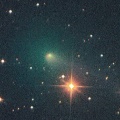
|
Now it is 14.2 mag (Sept. 25, Chris Wyatt). It stays observable in good condition after this. But it will be fading gradually after this.
Date(TT) R.A. (2000) Decl. Delta r Elong. m1 Best Time(A, h)
Oct. 15 1 5.90 -1 16.9 1.501 2.489 169 14.5 23:30 ( 0, 54)
Oct. 22 1 0.06 -1 45.4 1.562 2.531 163 14.7 22:56 ( 0, 53)
|

|
Now it is 15.0 mag (Oct. 2, Ken-ichi Kadota). The brightness evolution is slower than originally expected. It stays 14-15 mag for a long time. It locates extremely low in the Northern Hemisphere. In the Southern Hemisphere, it will be unobservable temporarily in November.
Date(TT) R.A. (2000) Decl. Delta r Elong. m1 Best Time(A, h)
Oct. 15 16 50.88 -25 51.9 3.457 2.970 53 14.5 18:49 ( 47, 11)
Oct. 22 16 54.67 -24 25.4 3.567 2.978 46 14.6 18:41 ( 51, 10)
|
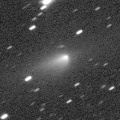
|
It brightened up to 12.7 mag in early 2022 (Feb. 27, Toshihiko Ikemura, Hirohisa Sato). Now it is fading. Now it is not observable. It will be observable agin at 16 mag in January in the Southern Hemisphere, or in February in the Northern Hemisphere.
Date(TT) R.A. (2000) Decl. Delta r Elong. m1 Best Time(A, h)
Oct. 15 14 21.39 -15 11.7 3.222 2.286 16 15.0 18:49 ( 78, -9)
Oct. 22 14 35.86 -16 27.0 3.255 2.299 13 15.1 18:41 ( 77,-11)
|
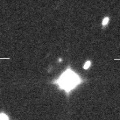
|
Now it is 15.1 mag (Oct. 9, A. Diepvens). It is expected to brighten up to 12.5 mag in winter. In the Northern Hemisphere, it will be observable in good condition after this. In the Southern Hemisphere, it is not observable until 2023 June.
Date(TT) R.A. (2000) Decl. Delta r Elong. m1 Best Time(A, h)
Oct. 15 12 11.46 18 59.4 3.147 2.360 31 15.2 4:41 (255, 11)
Oct. 22 12 21.60 20 1.9 3.018 2.304 37 15.0 4:47 (257, 16)
|
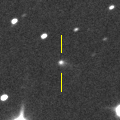
|
Now it is 16.6 mag (Oct. 12, ATLAS-MLO, Mauna Loa). It will brighten up to 14 mag in early 2023, and it will be observable in good condition. It is fainter than this ephemeris recently.
Date(TT) R.A. (2000) Decl. Delta r Elong. m1 Best Time(A, h)
Oct. 15 8 44.10 16 31.9 3.716 3.543 72 15.1 4:41 (289, 52)
Oct. 22 8 51.81 16 29.4 3.603 3.524 77 15.1 4:47 (296, 57)
|
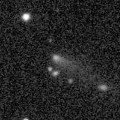
|
Now it is 15.5 mag (Oct. 2, Katsumi Yoshimoto). It stays 15 mag and observable in excellent condition until December.
Date(TT) R.A. (2000) Decl. Delta r Elong. m1 Best Time(A, h)
Oct. 15 2 41.51 19 4.0 1.473 2.423 157 15.2 1:10 ( 0, 74)
Oct. 22 2 35.85 20 11.8 1.447 2.421 164 15.1 0:37 ( 0, 75)
|

|
Now it is 15.1 mag (Sept. 28, ATLAS South Africa). It was expected to brighten up to 13 mag in spring. But actually, it was fainter than originally expected. In the Southern Hemisphere, it stays observable in good condition for a long time. In the Northern Hemisphere, it stays extremely low for a while.
Date(TT) R.A. (2000) Decl. Delta r Elong. m1 Best Time(A, h)
Oct. 15 5 52.87 -51 34.9 3.075 3.337 96 15.2 4:20 ( 0, 3)
Oct. 22 5 35.77 -52 39.1 3.047 3.361 99 15.2 3:36 ( 0, 2)
|
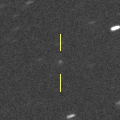
|
It will brighten up to 13 mag in winter. But the condition is bad. It is not observable until February in the Southern Hemisphere, or until May in the Northern Hemisphere.
Date(TT) R.A. (2000) Decl. Delta r Elong. m1 Best Time(A, h)
Oct. 15 13 55.01 -8 59.9 2.820 1.841 8 15.4 18:49 ( 86,-11)
Oct. 22 14 11.54 -10 50.0 2.796 1.811 6 15.2 18:41 ( 85,-13)
|
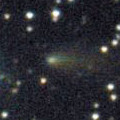
|
Now it is 14.8 mag (Oct. 3, Ken-ichi Kadota). It stays observable in good condition at 15 mag from summer to winter. It locates somwwhat low in the Southern Hemisphere.
Date(TT) R.A. (2000) Decl. Delta r Elong. m1 Best Time(A, h)
Oct. 15 7 34.87 19 13.6 2.168 2.370 88 15.4 4:41 (306, 66)
Oct. 22 7 43.20 19 6.7 2.094 2.380 93 15.4 4:47 (318, 70)
|
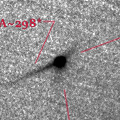
|
Due to the DART spacecraft impact to its satellite Dimorphos on Sept. 26, the cometary activity was detected. It brightened up to 12.9 mag (Sept. 28, John Drummond). It stays bright and observable in good condition until mid January
Date(TT) R.A. (2000) Decl. Delta r Elong. m1 Best Time(A, h)
Oct. 15 6 26.17 -11 23.9 0.079 1.015 101 15.4 4:41 (356, 43)
Oct. 22 7 7.43 -3 4.1 0.091 1.013 98 15.8 4:47 (352, 51)
|
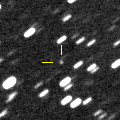
|
Now it is 14.9 mag (Oct. 7, ATLAS Chile). It will brighten up to 14 mag in 2023. In the Southern Hemisphere, it stays observable in good condition for a long time. It locates somewhat low in the Northern Hemisphere.
Date(TT) R.A. (2000) Decl. Delta r Elong. m1 Best Time(A, h)
Oct. 15 6 22.99 -18 27.4 3.556 3.863 100 15.6 4:41 (357, 37)
Oct. 22 6 15.17 -19 37.1 3.419 3.828 106 15.5 4:15 ( 0, 35)
|
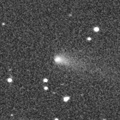
|
Now it is 14.9 mag (Oct. 8, Masayoshi Yoshimi). It stays 15.5 mag until November, and it stays observable in good condition.
Date(TT) R.A. (2000) Decl. Delta r Elong. m1 Best Time(A, h)
Oct. 15 1 27.94 1 42.3 1.134 2.127 173 15.5 23:52 ( 0, 57)
Oct. 22 1 24.32 0 57.5 1.141 2.126 168 15.6 23:21 ( 0, 56)
|
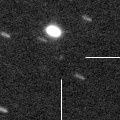
|
Now it is 14.9 mag (Oct. 5, X. Gao, Q.-Z. Ye). It is expected to brighten up to 8 mag in 2023 July. In 2022, it stays observable in good condition while the comet will be brightening gradually.
Date(TT) R.A. (2000) Decl. Delta r Elong. m1 Best Time(A, h)
Oct. 15 2 43.85 -3 18.8 2.940 3.871 155 15.7 1:12 ( 0, 52)
Oct. 22 2 31.89 -4 52.1 2.851 3.803 160 15.6 0:33 ( 0, 50)
|
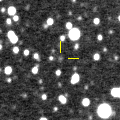
|
Now it is 16.5 mag (Oct. 7, ATLAS South Africa). It will brighten up to 13 mag from 2024 to 2025.
Date(TT) R.A. (2000) Decl. Delta r Elong. m1 Best Time(A, h)
Oct. 15 9 0.57 -30 25.8 7.557 7.174 63 16.0 4:41 (324, 14)
Oct. 22 9 3.80 -31 12.0 7.459 7.139 67 16.0 4:47 (330, 16)
|
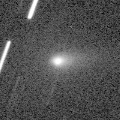
|
Now it is 14.2 mag (Sept. 25, Chris Wyatt). It brightened rapidly as predicted. It will be fading after this, and it will be fainter than 18 mag in December.
Date(TT) R.A. (2000) Decl. Delta r Elong. m1 Best Time(A, h)
Oct. 15 2 17.62 -32 0.7 0.735 1.617 137 16.0 0:45 ( 0, 23)
Oct. 22 2 17.22 -35 21.9 0.787 1.637 133 16.3 0:18 ( 0, 20)
|

|
Now it is 17.1 mag (Sept. 30, J.-C. Merlin). It stays at 15-16 mag for a long time. In the Southern Hemisphere, it stays observable in excellent condition for a long time, although it becomes extremely low temporarily in November. In the Northern Hemiphere, it is not observable after this.
Date(TT) R.A. (2000) Decl. Delta r Elong. m1 Best Time(A, h)
Oct. 15 14 35.87 -50 30.1 6.305 5.646 45 16.0 18:49 ( 44,-25)
Oct. 22 14 39.35 -51 0.7 6.375 5.670 41 16.1 18:41 ( 45,-27)
|
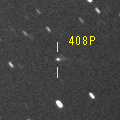
|
Now it is 16.4 mag (Oct. 8, ATLAS-HKO, Haleakala). It will be observable at 16-17 mag in excellent condition from autumn to winter.
Date(TT) R.A. (2000) Decl. Delta r Elong. m1 Best Time(A, h)
Oct. 15 4 38.43 3 43.0 2.740 3.468 130 16.2 3:06 ( 0, 59)
Oct. 22 4 37.33 2 52.1 2.678 3.468 136 16.1 2:37 ( 0, 58)
|
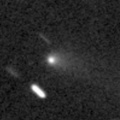
|
Now it is 15.8 mag (Oct. 2, Toshihiko Ikemura, Hirohisa Sato). Now it is fading. It stays 13-14 mag for a while. It is observable in excellent condition in the Southern Hemisphere. It locates somewhat low in the Northern Hemisphere.
Date(TT) R.A. (2000) Decl. Delta r Elong. m1 Best Time(A, h)
Oct. 15 22 17.05 -26 12.2 1.803 2.502 124 16.2 20:42 ( 0, 29)
Oct. 22 22 18.34 -25 19.4 1.917 2.541 118 16.5 20:16 ( 0, 30)
|
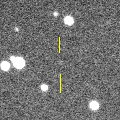
|
Now it is 16.1 mag (Oct. 10, ATLAS Chile). It is expected to brighten up to 7 mag in early 2024. In the Southern Hemisphere, it stays observable in good condition for a long time. In the Northern Hemisphere, it stays low in 2022.
Date(TT) R.A. (2000) Decl. Delta r Elong. m1 Best Time(A, h)
Oct. 15 6 21.08 -29 36.1 5.557 5.784 98 16.3 4:41 (358, 25)
Oct. 22 6 20.93 -30 43.9 5.433 5.722 101 16.3 4:20 ( 0, 24)
|
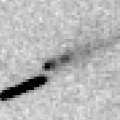
|
Now it is 16.1 mag (Sept. 23, Michael Jager). It stays observable at 16 mag from summer to winter. It will be getting higher after this also in the Southern Hemisphere. Michael Jager discovered a 18-mag fragment.
Date(TT) R.A. (2000) Decl. Delta r Elong. m1 Best Time(A, h)
Oct. 15 9 22.05 16 5.9 1.789 1.612 63 16.3 4:41 (282, 44)
Oct. 22 9 38.10 13 58.0 1.756 1.630 66 16.3 4:47 (288, 46)
|
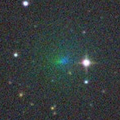
|
Brightened rapidly. It brightened up to 14.0 mag in early September (Sept. 2, Michael Jager). Now it is 16.0 mag (Sept. 26, Ken-ichi Kadota). It will be fading after this. In the Northern Hemisphere, it stays observable for a long time, although it becomes extremely low in November. It is not observable after this in the Southern Hemisphere.
Date(TT) R.A. (2000) Decl. Delta r Elong. m1 Best Time(A, h)
Oct. 15 15 17.47 17 30.3 2.254 1.608 39 16.4 18:49 ( 97, 21)
Oct. 22 15 16.99 17 56.9 2.309 1.624 36 16.5 18:41 (100, 17)
|
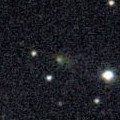
|
Now it is 16.5 mag (Oct. 1, Ken-ichi Kadota). It will be observable at 16-17 mag in good condition from summer to autumn.
Date(TT) R.A. (2000) Decl. Delta r Elong. m1 Best Time(A, h)
Oct. 15 3 37.97 27 39.2 1.621 2.483 141 16.6 2:06 ( 0, 83)
Oct. 22 3 33.87 27 28.4 1.600 2.509 149 16.6 1:35 ( 0, 83)
|
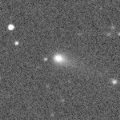
|
Now it is 16.1 mag (Oct. 12, ATLAS-HKO, Haleakala). It continued brightening even after the perihelion passage. It stays observable at 16 mag in good condition for a while.
Date(TT) R.A. (2000) Decl. Delta r Elong. m1 Best Time(A, h)
Oct. 15 22 58.77 -3 6.2 3.491 4.331 143 16.6 21:23 ( 0, 52)
Oct. 22 22 57.48 -3 20.8 3.573 4.344 135 16.7 20:54 ( 0, 52)
|

|
It brightened up to 14 mag in 2021. Now it is fading. It has already faded down to 15.9 mag (Oct. 3, ATLAS Chile). It is observable at 16-17 mag in 2022.
Date(TT) R.A. (2000) Decl. Delta r Elong. m1 Best Time(A, h)
Oct. 15 23 28.12 15 13.2 5.374 6.273 152 16.6 21:52 ( 0, 70)
Oct. 22 23 24.87 15 10.0 5.464 6.311 145 16.7 21:22 ( 0, 70)
|

|
Now it is 15.7 mag (Sept. 30, J. L. Virlichie, P. Traverse, H. Roy, G. Houdin). It brightened up to 14 mag from 2020 to 2021. Now it is fading slowly. It is observable at 16-17 mag in 2022.
Date(TT) R.A. (2000) Decl. Delta r Elong. m1 Best Time(A, h)
Oct. 15 0 17.31 -20 7.8 3.133 4.012 147 16.7 22:41 ( 0, 35)
Oct. 22 0 13.41 -20 5.4 3.201 4.030 141 16.8 22:10 ( 0, 35)
|
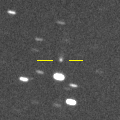
|
Now it is 17.7 mag (July 9, ATLAS Chile). It will brighten up to 16 mag in 2023. In the Southern Hemisphere, it stays observable in good condition for a long time. In the Northern Hemisphere, it will never be observable again.
Date(TT) R.A. (2000) Decl. Delta r Elong. m1 Best Time(A, h)
Oct. 15 11 59.43 -38 3.5 4.206 3.434 34 17.0 4:41 (304,-18)
Oct. 22 12 10.30 -39 55.1 4.169 3.412 35 16.9 4:47 (308,-16)
|

|
It brightened up to 14.2 mag in 2021 summer (July 18, 2021, Taras Prystavski). Now it is fading. It has already faded down to 16.7 mag (Oct. 6, ATLAS Chile). In the Southern Hemisphere, it stays observable in good condition for a long time. It locates somewhat low in the Northern Hemisphere.
Date(TT) R.A. (2000) Decl. Delta r Elong. m1 Best Time(A, h)
Oct. 15 1 47.22 -26 48.1 4.661 5.501 144 17.0 0:15 ( 0, 28)
Oct. 22 1 42.00 -26 31.4 4.720 5.544 142 17.1 23:38 ( 0, 29)
|
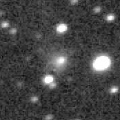
|
Now it is 17.1 mag (Oct. 2, Toshihiko Ikemura, Hirohisa Sato). It stayed bright for a while even after the perihelion passage, but it will be fading after this. It will be fainter than 18 mag in winter.
Date(TT) R.A. (2000) Decl. Delta r Elong. m1 Best Time(A, h)
Oct. 15 21 17.17 1 35.0 6.675 7.219 119 17.1 19:42 ( 0, 57)
Oct. 22 21 15.45 0 43.7 6.808 7.245 112 17.1 19:13 ( 0, 56)
|

|
Now it is 16.8 mag (Oct. 1, ATLAS-MLO, Mauna Loa). Fading slowly. In the Northern Hemisphere, it stays observable in good condition for a long time. In the Southern Hemisphere, it is not observable after this.
Date(TT) R.A. (2000) Decl. Delta r Elong. m1 Best Time(A, h)
Oct. 15 17 10.98 63 48.0 9.493 9.444 84 17.1 18:49 (150, 49)
Oct. 22 17 13.04 63 27.8 9.508 9.459 84 17.1 18:41 (148, 47)
|
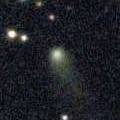
|
Now it is 16.6 mag (Oct. 2, Toshihiko Ikemura, Hirohisa Sato). It stays observable at 16 mag from 2021 to 2022. It locates low in the Southern Hemisphere.
Date(TT) R.A. (2000) Decl. Delta r Elong. m1 Best Time(A, h)
Oct. 15 16 4.54 37 55.2 5.984 5.557 60 17.1 18:49 (113, 39)
Oct. 22 16 11.07 37 45.3 6.026 5.586 59 17.1 18:41 (114, 36)
|
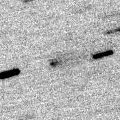
|
Now it is 18.0 mag (Oct. 2, M. Jaeger, E. Prosperi, S. Prosperi). It stays observable at 17 mag until winter. In the Southern Hemisphere, it locates extremely low until autumn.
Date(TT) R.A. (2000) Decl. Delta r Elong. m1 Best Time(A, h)
Oct. 15 9 6.47 17 5.7 2.348 2.168 67 17.2 4:41 (284, 48)
Oct. 22 9 17.25 15 45.7 2.298 2.194 71 17.2 4:47 (290, 51)
|
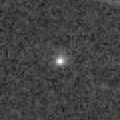
|
Now it is 16.3 mag (Oct. 3, ATLAS Chile). It stays observable at 17-18 mag until next summer. It may be brighter than this ephemeris.
Date(TT) R.A. (2000) Decl. Delta r Elong. m1 Best Time(A, h)
Oct. 15 23 54.68 -13 55.0 1.228 2.148 149 17.3 22:16 ( 0, 41)
Oct. 22 23 15.87 -14 56.3 1.268 2.094 134 17.2 21:10 ( 0, 40)
|
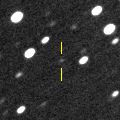
|
Now it is 17.8 mag (July 8, ATLAS Chile). It is expected to brighten up to 12-13 mag from 2024 to 2025.
Date(TT) R.A. (2000) Decl. Delta r Elong. m1 Best Time(A, h)
Oct. 15 10 29.90 -18 21.0 7.601 6.894 42 17.3 4:41 (300, 9)
Oct. 22 10 31.50 -18 34.2 7.486 6.850 47 17.2 4:47 (306, 14)
|
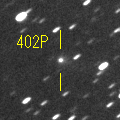
|
It brightened up to 15.3 mag in last winter (Jan. 12, H. Nohara). Now it is fading. It has already faded down to 17.7 mag (Oct. 3, Catalina Sky Survey). It will be observable at 17 mag in good condition in next winter. It locates somewhat low in the Southern Hemisphere.
Date(TT) R.A. (2000) Decl. Delta r Elong. m1 Best Time(A, h)
Oct. 15 9 48.70 18 12.2 4.737 4.296 58 17.3 4:41 (275, 40)
Oct. 22 9 54.79 18 13.7 4.657 4.311 63 17.3 4:47 (280, 45)
|
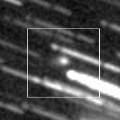
|
Now it is 17.3 mag (Oct. 4, ATLAS-MLO, Mauna Loa). It is expected to brighten up to 11-12 mag in 2024. In the Northern Hemisphere, it stays observable in good condition for a long time until 2023 autumn, although it becomes temporarily low in December. In the Southern Hemisphere, it becomes unobservable in October. But it will be observable in excellent condition at the high light.
Date(TT) R.A. (2000) Decl. Delta r Elong. m1 Best Time(A, h)
Oct. 15 17 55.50 22 4.1 5.799 5.611 74 17.3 18:49 ( 78, 55)
Oct. 22 17 55.64 21 2.6 5.832 5.559 69 17.3 18:41 ( 81, 51)
|
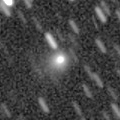
|
It brightened by 6 mag in outburst up to 14.6 mag (Aug. 13, ATLAS-MLO, Mauna Loa). Now it is fading. But it is bright as 16.1 mag still now (Oct. 1, Toshihiko Ikemura, Hirohisa Sato). It stays observable in good condition for a while.
Date(TT) R.A. (2000) Decl. Delta r Elong. m1 Best Time(A, h)
Oct. 15 19 8.97 -1 43.5 1.715 1.943 87 17.3 18:49 ( 29, 49)
Oct. 22 19 21.08 -3 8.2 1.748 1.912 83 17.6 18:41 ( 31, 47)
|

|
It approached to Sun down to 0.14 a.u. on May 15. But it was not observable around that time. In the Northern Hemisphere, it stays observable at 17-18 mag in good condition from July to November. In the Southern Hemisphere, it stays extremely low.
Date(TT) R.A. (2000) Decl. Delta r Elong. m1 Best Time(A, h)
Oct. 15 2 53.03 45 53.3 1.278 2.121 137 17.4 1:22 (180, 79)
Oct. 22 2 30.89 44 52.3 1.268 2.158 144 17.3 0:33 (180, 80)
|

|
Now it is 17.2 mag (Oct. 1, D. Buczynski). It stays observable at 17-18 mag in 2022. It locates somewhat low in the Southern Hemisphere.
Date(TT) R.A. (2000) Decl. Delta r Elong. m1 Best Time(A, h)
Oct. 15 1 32.91 26 38.0 4.582 5.536 161 17.4 0:02 ( 0, 82)
Oct. 22 1 23.00 25 44.3 4.585 5.549 164 17.4 23:19 ( 0, 81)
|

|
It brightened very rapidly up to 15.5 mag from last autumn to last winter (Nov. 2, 2021, Toshihiko Ikemura, Hirohisa Sato). Now it is fading. It has already faded down to 17.1 mag (Oct. 9, Mt. Lemmon Survey).
Date(TT) R.A. (2000) Decl. Delta r Elong. m1 Best Time(A, h)
Oct. 15 6 46.77 12 46.0 3.986 4.266 99 17.4 4:41 (339, 67)
Oct. 22 6 48.46 12 18.9 3.903 4.284 105 17.4 4:47 (359, 67)
|
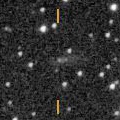
|
Now it is 17.1 mag (Oct. 3, Ken-ichi Kadota). In the Northern Hemisphere, it stays observable at 17 mag in good condition for a long time until winter. In the Southern Hemisphere, it stays extremely low for a long time.
Date(TT) R.A. (2000) Decl. Delta r Elong. m1 Best Time(A, h)
Oct. 15 7 38.48 46 48.4 2.620 2.847 92 17.4 4:41 (227, 70)
Oct. 22 7 48.49 47 13.6 2.561 2.864 97 17.4 4:47 (219, 73)
|
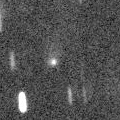
|
Now it is 17.9 mag (Oct. 4, M. Iozzi). It started fading before the perihelion passage. It was predicted to stay at 16 mag for a long time. But actually, it will be fainter than 18 mag in autumn. In the Northern Hemisphere, it stays observable in good condition for a long time. In the Southern Hemisphere, it is not observable until 2023.
Date(TT) R.A. (2000) Decl. Delta r Elong. m1 Best Time(A, h)
Oct. 15 17 49.89 47 47.7 4.066 4.044 81 17.6 18:49 (126, 59)
Oct. 22 17 56.59 45 19.1 4.127 4.067 79 17.7 18:41 (121, 57)
|
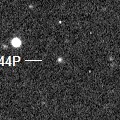
|
Now it is 18.7 mag (Oct. 5, J.-G. Bosch, F. Kugel). It is observable at 17 mag in good condition in winter. It locates somewhat low in the Southern Hemisphere.
Date(TT) R.A. (2000) Decl. Delta r Elong. m1 Best Time(A, h)
Oct. 15 6 29.88 25 45.6 3.551 3.923 104 17.7 4:41 (338, 80)
Oct. 22 6 31.78 25 48.6 3.452 3.922 111 17.6 4:32 ( 0, 81)
|

|
Now it is 17.5 mag (Oct. 1, Ken-ichi Kadota). In the Northern Hemisphere, it is observable at 17-18 mag in excellent condition in autumn. It is not observable in the Southern Hemisphere.
Date(TT) R.A. (2000) Decl. Delta r Elong. m1 Best Time(A, h)
Oct. 15 7 45.45 46 2.6 2.483 2.698 91 17.8 4:41 (231, 70)
Oct. 22 7 54.89 48 41.4 2.423 2.722 96 17.8 4:47 (218, 71)
|

|
Now it is 19.7 mag (Oct. 2, Pan-STARRS 1, Haleakala). It is observable at 17 mag in excellent condition in winter.
Date(TT) R.A. (2000) Decl. Delta r Elong. m1 Best Time(A, h)
Oct. 15 8 33.31 7 49.6 3.731 3.567 72 17.9 4:41 (302, 48)
Oct. 22 8 39.50 6 60.0 3.628 3.558 78 17.8 4:47 (311, 52)
|
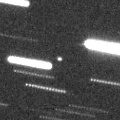
|
Now it is 17.1 mag (Oct. 1, Toshihiko Ikemura, Hirohisa Sato). In 2022, it stays observable at 17 mag for a long time.
Date(TT) R.A. (2000) Decl. Delta r Elong. m1 Best Time(A, h)
Oct. 15 8 0.32 22 29.5 0.765 1.189 83 17.8 4:41 (291, 64)
Oct. 22 8 10.85 21 36.0 0.777 1.242 88 17.9 4:47 (301, 67)
|
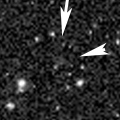
|
Now it is 17.5 mag (Oct. 2, ATLAS South Africa). Very far object. It stays 18 mag for a long time from 2021 to 2026. In the Southern Hemisphere, it stays observable in good condition for a long time. In the Northern Hemisphere, it is not observable at all.
Date(TT) R.A. (2000) Decl. Delta r Elong. m1 Best Time(A, h)
Oct. 15 8 20.95 -69 16.4 10.712 10.528 76 17.9 4:41 (349,-17)
Oct. 22 8 19.66 -70 6.8 10.702 10.521 76 17.9 4:47 (352,-16)
|
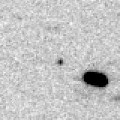
|
It stays observable at 16 mag for a long time from early 2023 to early 2024. In the Northern Hemisphere, it is observable only until 2023 spring.
Date(TT) R.A. (2000) Decl. Delta r Elong. m1 Best Time(A, h)
Oct. 15 10 27.06 11 40.3 5.411 4.788 47 18.0 4:41 (276, 28)
Oct. 22 10 29.39 10 40.9 5.281 4.751 53 17.9 4:47 (282, 34)
|

|
Now it is 18.1 mag (Oct. 7, ATLAS-MLO, Mauna Loa). It will brighten rapidly, and it will be observable at 16 mag in good condition in winter.
Date(TT) R.A. (2000) Decl. Delta r Elong. m1 Best Time(A, h)
Oct. 15 8 12.53 17 36.7 1.752 1.857 79 18.1 4:41 (296, 58)
Oct. 22 8 27.91 17 4.4 1.681 1.849 83 17.9 4:47 (302, 61)
|
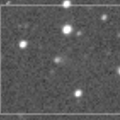
|
It was observed at 17 mag in 2021. It was expected to be observable at 17-18 mag also in 2022. But actually, it is much fainter than last year by 3 mag, 20.8 mag (Oct. 1, Pan-STARRS 2, Haleakala).
Date(TT) R.A. (2000) Decl. Delta r Elong. m1 Best Time(A, h)
Oct. 15 2 35.43 14 56.9 2.664 3.618 160 19.9 1:04 ( 0, 70)
Oct. 22 2 28.79 15 27.5 2.660 3.641 168 19.9 0:30 ( 0, 71)
|
|
![]()
 C/2019 U5 ( PanSTARRS )
C/2019 U5 ( PanSTARRS ) C/2022 R2 ( ATLAS )
C/2022 R2 ( ATLAS ) C/2021 Y1 ( ATLAS )
C/2021 Y1 ( ATLAS ) 29P/Schwassmann-Wachmann 1
29P/Schwassmann-Wachmann 1 117P/Helin-Roman-Alu 1
117P/Helin-Roman-Alu 1 22P/Kopff
22P/Kopff C/2020 R7 ( ATLAS )
C/2020 R7 ( ATLAS ) 116P/Wild 4
116P/Wild 4 C/2022 A2 ( PanSTARRS )
C/2022 A2 ( PanSTARRS ) C/2020 S4 ( PanSTARRS )
C/2020 S4 ( PanSTARRS ) P/2022 L3 ( ATLAS )
P/2022 L3 ( ATLAS ) C/2020 Y2 ( ATLAS )
C/2020 Y2 ( ATLAS ) 71P/Clark
71P/Clark 119P/Parker-Hartley
119P/Parker-Hartley (65803) Didymos
(65803) Didymos C/2021 X1 ( Maury-Attard )
C/2021 X1 ( Maury-Attard ) 61P/Shajn-Schaldach
61P/Shajn-Schaldach C/2021 T4 ( Lemmon )
C/2021 T4 ( Lemmon ) C/2021 G2 ( ATLAS )
C/2021 G2 ( ATLAS ) 327P/Van Ness
327P/Van Ness C/2018 U1 ( Lemmon )
C/2018 U1 ( Lemmon ) 408P/2020 M7 ( Novichonok-Gerke )
408P/2020 M7 ( Novichonok-Gerke ) 9P/Tempel 1
9P/Tempel 1 C/2021 S3 ( PanSTARRS )
C/2021 S3 ( PanSTARRS ) 157P/Tritton
157P/Tritton C/2022 L1 ( Catalina )
C/2022 L1 ( Catalina ) 44P/Reinmuth 2
44P/Reinmuth 2 395P/2020 H1 ( Catalina-NEAT )
395P/2020 H1 ( Catalina-NEAT ) C/2020 F5 ( MASTER )
C/2020 F5 ( MASTER ) 246P/NEAT
246P/NEAT C/2021 C5 ( PanSTARRS )
C/2021 C5 ( PanSTARRS ) C/2019 F1 ( ATLAS-Africano )
C/2019 F1 ( ATLAS-Africano ) C/2019 T3 ( ATLAS )
C/2019 T3 ( ATLAS ) C/2019 O3 ( Palomar )
C/2019 O3 ( Palomar ) C/2020 H6 ( ATLAS )
C/2020 H6 ( ATLAS ) P/2022 P2 ( ZTF )
P/2022 P2 ( ZTF ) C/2022 Q2 ( ATLAS )
C/2022 Q2 ( ATLAS ) C/2022 E2 ( ATLAS )
C/2022 E2 ( ATLAS ) 402P/2020 Q3 ( LINEAR )
402P/2020 Q3 ( LINEAR ) C/2022 L2 ( ATLAS )
C/2022 L2 ( ATLAS ) 285P/LINEAR
285P/LINEAR (3200) Phaethon
(3200) Phaethon C/2020 U4 ( PanSTARRS )
C/2020 U4 ( PanSTARRS ) P/2021 N2 ( Fuls )
P/2021 N2 ( Fuls ) C/2021 QM45 ( PanSTARRS )
C/2021 QM45 ( PanSTARRS ) C/2020 U5 ( PanSTARRS )
C/2020 U5 ( PanSTARRS ) 244P/Scotti
244P/Scotti C/2022 P3 ( ZTF )
C/2022 P3 ( ZTF ) P/2021 V2 ( Fuls )
P/2021 V2 ( Fuls ) 107P/(4015) Wilson-Harrington
107P/(4015) Wilson-Harrington C/2019 E3 ( ATLAS )
C/2019 E3 ( ATLAS ) C/2022 A3 ( Lemmon-ATLAS )
C/2022 A3 ( Lemmon-ATLAS ) 204P/LINEAR-NEAT
204P/LINEAR-NEAT 422P/2021 L1 ( Christensen )
422P/2021 L1 ( Christensen )![]()






























































